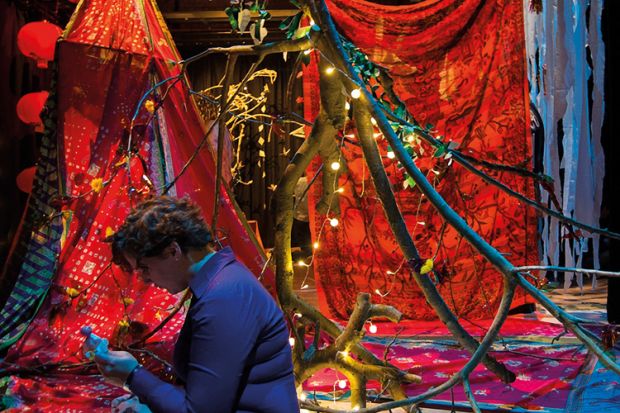Crawl through a tunnel lined with AstroTurf and planted with herbs, and discover in the darkness a flickering campfire surrounded by cushions. Rummage through a giant apothecary cabinet and slip into fancy dress. Write a letter to your past self, or use Play-Doh and Lego to build what your imagination looks like.
These are all possible when you enter the Dark Would, the newest addition to the University of Warwick’s campus. The learning spaces of the future may not look like traditional lecture theatres, but how many in the sector imagined that they would resemble this?
The Dark Would is the creation of three members of Warwick’s Institute for Advanced Teaching and Learning, who wanted to develop an environment that would give staff and students the intellectual and physical space to reimagine their ideas and challenge conventional wisdom.
After discovering that sitting on the floor during their meetings helped to put them in a different frame of mind, Rebecca Fisher, Amy Clarke and Naomi de la Tour took over part of a drama studio at the institute to create the forest-inspired wonderland.
“We tried to build a place that would create an atmosphere that would be non-hierarchical, that would allow students and teachers to explore topics and content together,” said Dr Fisher. “We wanted a space that created a sense of almost being childlike, where you genuinely explore something not necessarily knowing where you are going, being curious about learning rather than having a sense that the teacher knows all the answers.”
This explains the crawling, which is designed to make visitors to the Dark Would start to engage with their surroundings and to slow down. The darkness, meanwhile, is designed to add a feeling of risk and create a sense of gradual discovery.
There is no lecturer to tell students what to do, but there are a series of tasks for them to complete.
One of the most successful uses of the Dark Would so far was in a module on applied imagination, which involved undergraduates from a wide range of disciplines.
Students were invited to use crafting materials to create a vision of what their imagination looked like, and to sit around the campfire and to ponder, like a riddle, the workings of their imagination.
This was followed by a more conventional discussion with a lecturer, and the end result, Dr Fisher said, was that students were able to think about their imagination in much more creative ways. Feedback was very positive, she added.
The space has also been used by academics attending the National Co-ordinating Centre for Public Engagement conference at Warwick, and another UK university has already decided to create its own version of the Dark Would.
Dr Fisher conceded that not all initial reactions to the Dark Would have been positive, with one academic becoming “quite angry” at an initiative that he regarded as “frippery” and “superficial”.
But she said that most people came round to the idea after spending 45 minutes to an hour in the space, recognising that they were just not used to thinking in a way that is less goal-orientated, and that is harder to find space for in everyday working life.
“We find the Dark Would isn’t a replacement of traditional or different types of teaching, but is a complementary method,” Dr Fisher said. “It works really well in creating a cohort identity and giving students a feeling of being free and open-minded, and of being able to pursue questions and challenges in a way that is different.”
The Dark Would is yet to be used in scientific disciplines, and does lend itself better to more abstract topics. However, science students who took the applied imagination module reported that it was an invigorating experience.
So could spaces like this be important for the universities of the future? Dr Fisher, a postdoctoral associate fellow in Warwick’s department of English and comparative literary studies, argued that there was a case for an alternative to the lecture theatre of the future, one that provoked emotional as well as intellectual responses to issues.
“This is not a space that is full of tables, chairs, lecterns and PowerPoint screens,” she said. “By stripping these away you take away things that students and teachers hide behind, and you make the connections in the space more immediate.”
POSTSCRIPT:
Print headline: Enter the Dark Would and set your imagination free
Register to continue
Why register?
- Registration is free and only takes a moment
- Once registered, you can read 3 articles a month
- Sign up for our newsletter
Subscribe
Or subscribe for unlimited access to:
- Unlimited access to news, views, insights & reviews
- Digital editions
- Digital access to THE’s university and college rankings analysis
Already registered or a current subscriber? Login







